Arts & Culture
Santonilyo: The Pagan Origins of Santo Nino
Santonilyo was said to be an old and a new god to the pantheon of ancient Visayas. In relation to this, it was also believed that this was also connected to the Santo Nino de Cebu.
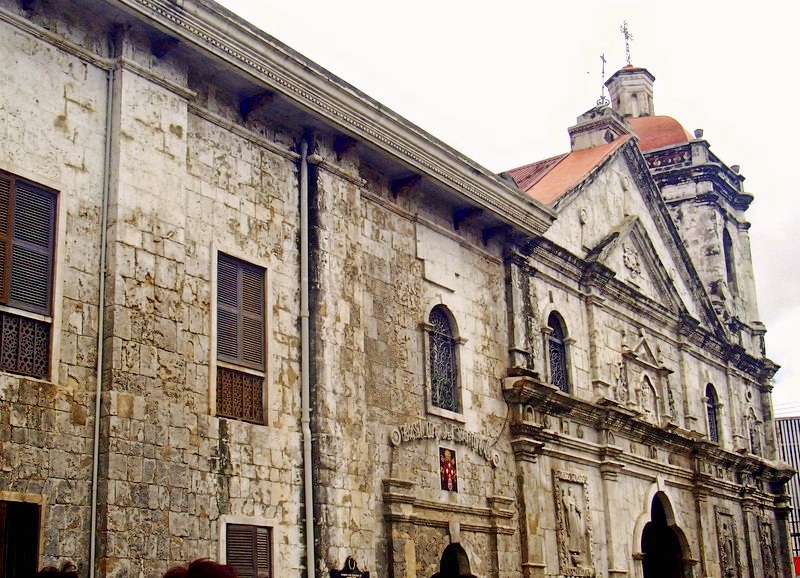

In Cebu, some, if not most, establishments or residences have always kept an altar or a pedestal with a carved wooden statue of a little king, clothed in rich fabric of red or green, wearing a golden necklace and bearing a scepter and a globus cruciger in his hands. This figure was brought by the Spaniards and is known as Santo Niño. This image is revered by Cebuanos, holding festivities in honor of the miraculous child Jesus.
During the pre-Spanish colonial era, our ancestors had similar wooden idols named as guardians, protectors and pagan deities. This brought a similar legend about a piece of drift wood that turned out to be miraculous, and scared away creatures when placed on the farms. Let’s take a look at the origins of the religious image that once was said to be a pagan god and converted to the catholic path to many of us believe in.
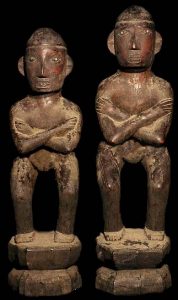
Ifugao “Bulul” Pair Rice God Statue with Inlaid bead eyes considered as a Lianito credits to www.tribalasia.com
The Lianito Idol
The Animist people of the Visayas region worshipped a time god known as Kaptan, equivalent to the creator god Bathala of the Tagalogs. He was the supreme deity in the Visayan pantheon, but relatively distant. To bridge the gap of the activities of heaven and the mortals, the ancient people replaced mediators such nature-based deities known as diwatas (fairies and elementals) and anitos (ancestral spirits) who supposed to give blessings and abundance on a family or a society.
Furthermore, these “Anito” spirits are usually old ancestors who have lived a virtuous life when they were alive. Each house in the ancient Visayas was supposed to carry a “tawu tawu”(idols) made out of wood, stone, gold or ivory whom the family pay honor in resemblance of offering food or flowers and “pag-anito”(worship) to ensure and continue daily blessings upon them. When the head of a family dies, everyone in the village help make the statue, they would carve out an androgynous (to further symbolize gender-equality), child-like image, and always smiling to what they would call the “Lianito”, the collective embodiment of the ancestor spirit of a family and territory and they would dress the doll with gold and would place the image among the other idols.

Painting of Queen Juana (Hara Humamay) by Filipino artist Manuel Panares
The Baptism
The birth of Catholicism in Cebu was through the image of Santo Niño de Cebu, brought by the Spanish Occupation through Antonio Pigafetta, an Italian scribe of Ferdinand Magellan, given as a gift to Hara Humamay the royal consort of the chieftain of Cebu of 1521, Rajah Humabon, as token of good relations and allegiance to Spain. The queen was baptized to Catholicism and renounced her animist beliefs and dubbed a new Christian name, “Juana”.
Queen Juana loved the image so much that according to the account of Pigafetta upon receiving, she bathed the statue with her tears of joy as she is hugging it. Eight hundred Cebuanos were baptized as well and were given an image of the Virgin Mary, a crucifix and a bust depiction of Jesus before Pontius Pilate. The Spaniards underestimated the animist faith that Magellan discovered that the king and queen still keep their Lianitos. The queen perhaps readily accepted the Santo Niño because it looked more regal and refined. Rest of the history follows of another chieftain’s refusal of conquering the land and instilling tradition that was Datu Lapu-Lapu and had a violent conflict which caused Magellan’s death.
Moving on its dark past of the conquest through religion, 44 years after Magellan came Miguel Lopez De Legazpi, arrived Cebu and found the native’s hostility and fearing the retribution for Magellan’s death. The villages were burned during the progressing conflict. Juan Camus, a Spanish mariner found the image of the Santo Nino in a pine box amidst the ruins of a burned-down hut. Presented the image to Legazpi and the Augustinian priests; the natives denied the gift was associated to Magellan and claimed it have been there for a long time. A church was built on the spot to where the image was found that was originally in bamboo and mangrove palms then was reconstructed later and claims to be the oldest parish in the Philippines.
The Youthful Deity of the Rain
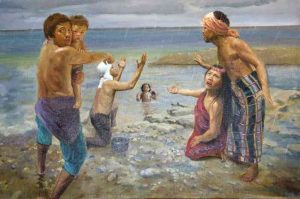
Visayan natives submerse the Santo Nino image to venerate with and call out for the rain.
Filipino Historian Nico Marquez Joaquin’s workes in 1980 state that it was also within the time gap of those 44 years since Magellan that the natives discovered a new god in the pantheon of the Visayas. The new deity in the form of a child they call Santonilyo. Influenced in its Spanish title, they recognized the statue as a lianito describing both an old and a new god to the Visayans.
Santonilyo is the child deity of good graces who was worshiped as a rain god for four decades since the Spanish first arrived. Fray Gaspar de San Agustin wrote about it in 1565 book “Conquistas de las Islas Filipinas”, that during drought, the ancient Cebuanos would bathe the image in the sea.
“Cun ulan ang pangayoon, ug imong pagadugayon. Dadad-on ca sa baybayon, ug sa dagat pasalomon. Ug dayon nila macuha ang guitinguha.”
Which translates: “If they seek rain and you delay it, you’d be brought to the shore and bathed in the sea. They then obtain the rain they desire.” The practice of immersing the sacred image is also mentioned in the Sto. Niño’s Gozos (prayer hymn) published in an 1888 novena.
However, Santonilyo’s popularity was already widespread among the Visayan islands reaching the Panay, Mindoro, Negros, Bohol, Siquijor, Samar and Leyte. The Santonilyo as mentioned by Felipe Landa Jocano, an anthropologist and author of “Filipino Value System”, as one of the supporting Upper world deities along with Ribung Linti (god of thunder and lightning) who assisted Tungkung Langit (the creator god of Panay Islands) in the creation myth known as the “Sulod” Epics.
In its connection of the legend of Panay that Santonilyo was said to have reached the islands as a fisherman caught a piece of “agipo” (or a driftwood) but couldn’t catch fish the whole day. Dismayed, he threw it back soon after, felt another tug to his net and realized it’s the same driftwood and over and over again would dump it on the sea, known only to catch the same agipo again.
Tired and frustrated, the fisherman decided to keep the driftwood in his boat, and like a miracle, fish flocked towards his boat and returned to the village with a bountiful catch. The villagers soon discovered that the piece of wood had other magical powers used as a scarecrow to keep the birds and animals away in drying the grains and in times of drought, only had to immerse the driftwood in the sea to produce rains.
This agipo became an idol in their pantheon, and like the venerated Holy Child, Santonilyo is also prayed for graces. The Lianito idol then on was called Lisantonilyo. As Santo Nino has been honored and prayed in Cebu, we are able to peak in the origins of our faith based on discovery and documents not diminishing the fact on what we truly believe in which is God represented as a sweet, youthful child that would save the whole world from sin.
Arts & Culture
Asia’s Fashion Czar I Knew as Tito Pitoy; Remembrance of a Friendship Beyond Fashion with Designer Jose R. Moreno
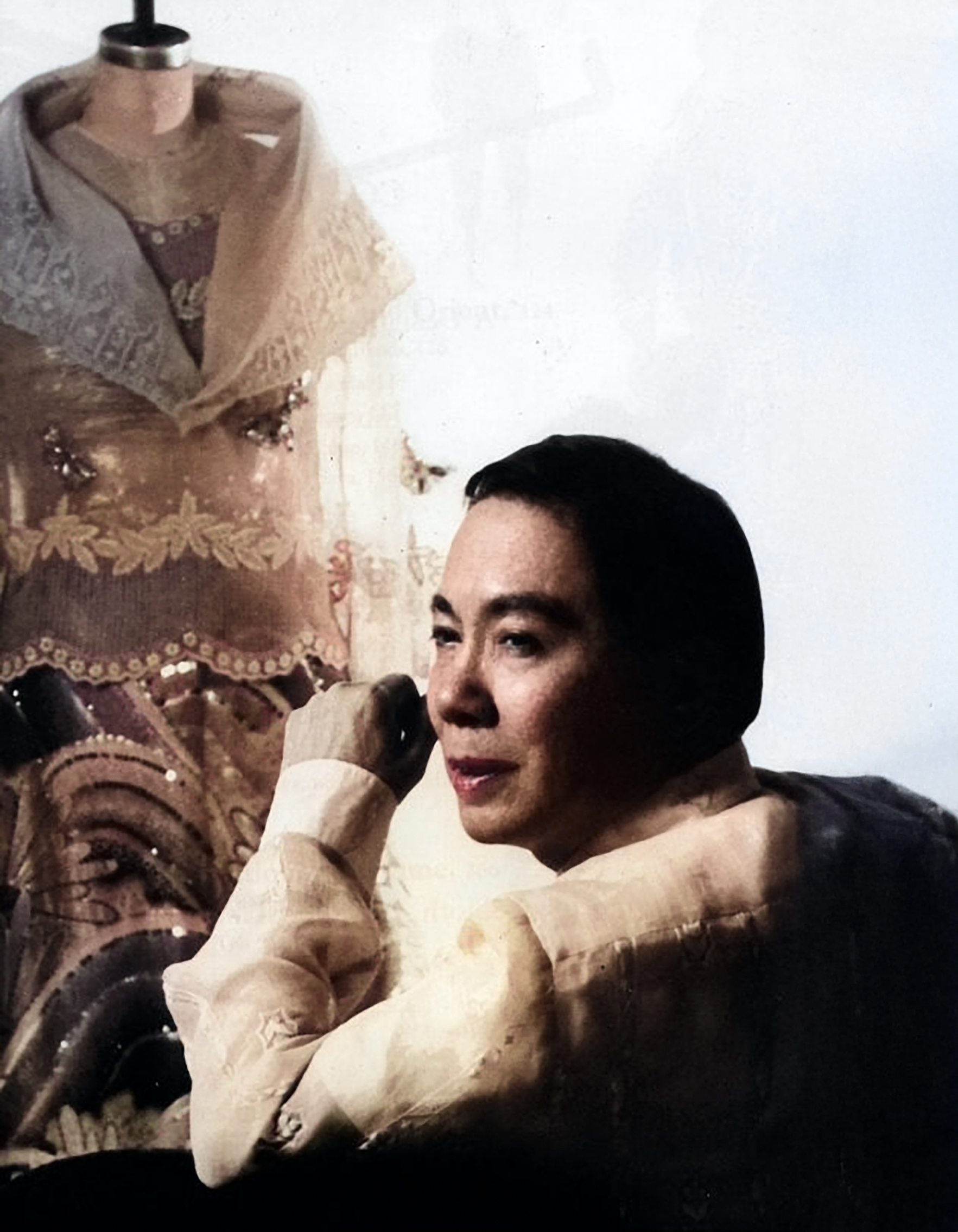
by Jose Carlos G. Campos, Board of Trustees National Museum of the Philippines
My childhood encounter with the famous Pitoy Moreno happened when I was eight years old. My maternal grandmother, Leonila D. Garcia, the former First Lady of the Philippines, and my mother, Linda G. Campos, along with my Dimataga aunts, brought me to his legendary atelier on General Malvar Street in Malate, Manila. These were the unhurried years of the 1970s.
As we approached the atelier, I was enchanted by its fine appointments. The cerulean blue and canary yellow striped canopies shaded tall bay windows draped in fine lace—no signage needed, the designer’s elegance spoke for itself. Inside, we were led to a hallway adorned with Art Deco wooden filigree, and there was Pitoy Moreno himself waiting with open arms—”Kamusta na, Inday and Baby Linda,” as he fondly called Lola and Mommy.
“Ahhh Pitoy, it’s been a while,” Lola spoke with joy.
“Oh eto, may kasal na naman,” my mom teasingly smiled.

Linda Garcia Campos and Pitoy Moreno’s friendship started when they were students in the University of the Philippines in Diliman.

When Dame Margot Fonteyn came for a visit to Manila, Pitoy Moreno dressed her up for an occasion.
We had entered a world of beauty—porcelain figurines, ancient earthenware and pre-colonial relics. It was like stepping into a looking glass, only Pitoy could have imagined.
Destiny led me back years later when my mother Linda told me that Pitoy Moreno was working on his second book, Philippine Costume, and needed research material and editorial advice. At this point, around the 1990s, I was in between assignments—unsure of how a broadcasting graduate like me could possibly contribute to a fashion icon’s masterpiece. Fortunately, I agreed to the project.
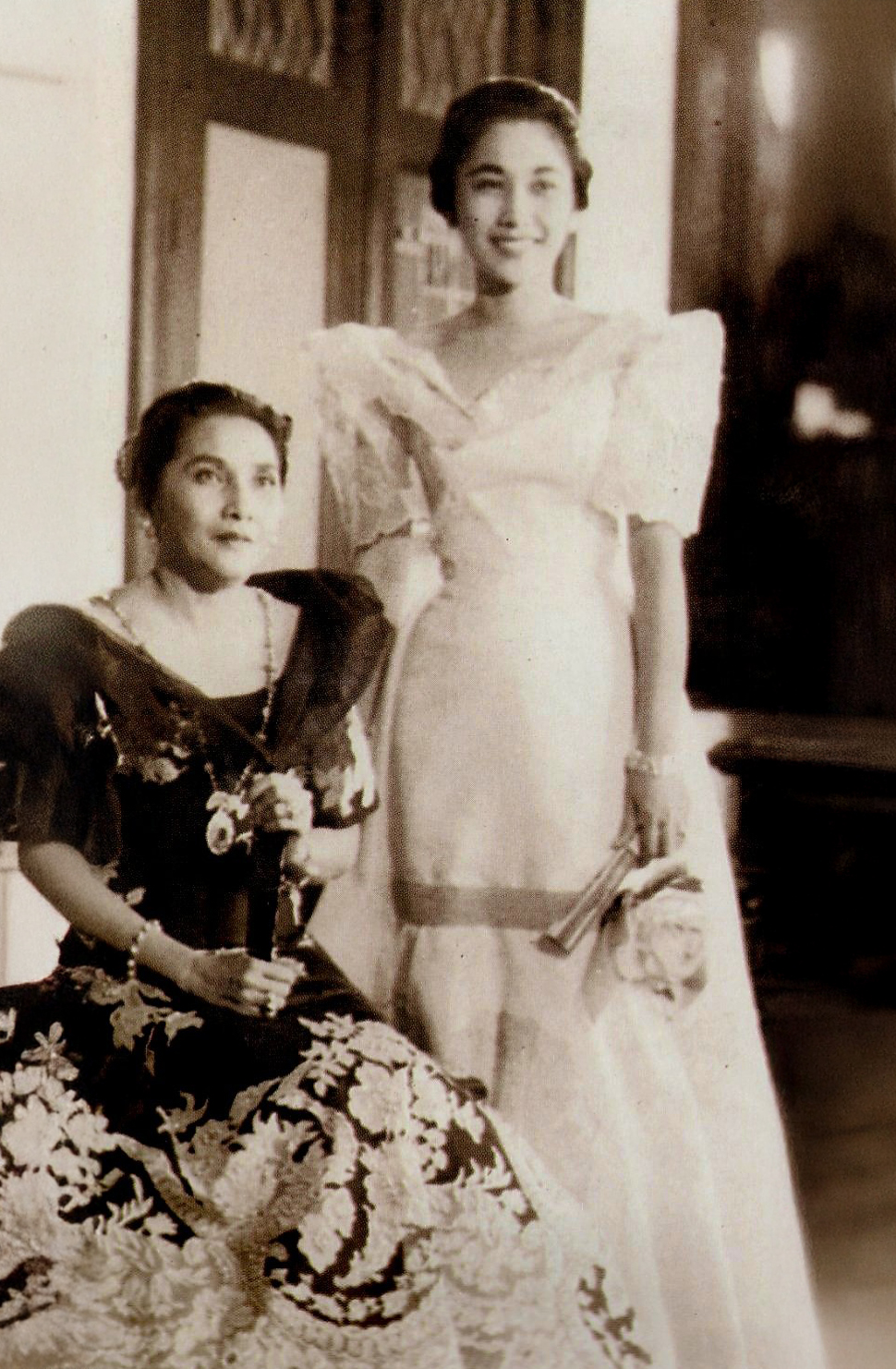
Former First Lady Leonila D. Garcia and daughter Linda G. Campos in Malacañang Palace.
Returning to the designer’s atelier brought back a rush of pleasant memories. The gate opened, and there stood Pitoy Moreno, beaming as always.
“Come in, hijo. Let me show you what I have in mind—and call me Tito Pitoy, okay?”
He led me to his worktable.
“I want to publish a book that tells the story of Philippine fashion—from our pre-colonial roots to the present. A designer’s collection of images and heritage expressed in clothing.”
I was awestruck. “How can I help you?” I inquired.
“Did you know that your mother, Linda, was my barkada in the University of the Philippines in Diliman?” he grinned.
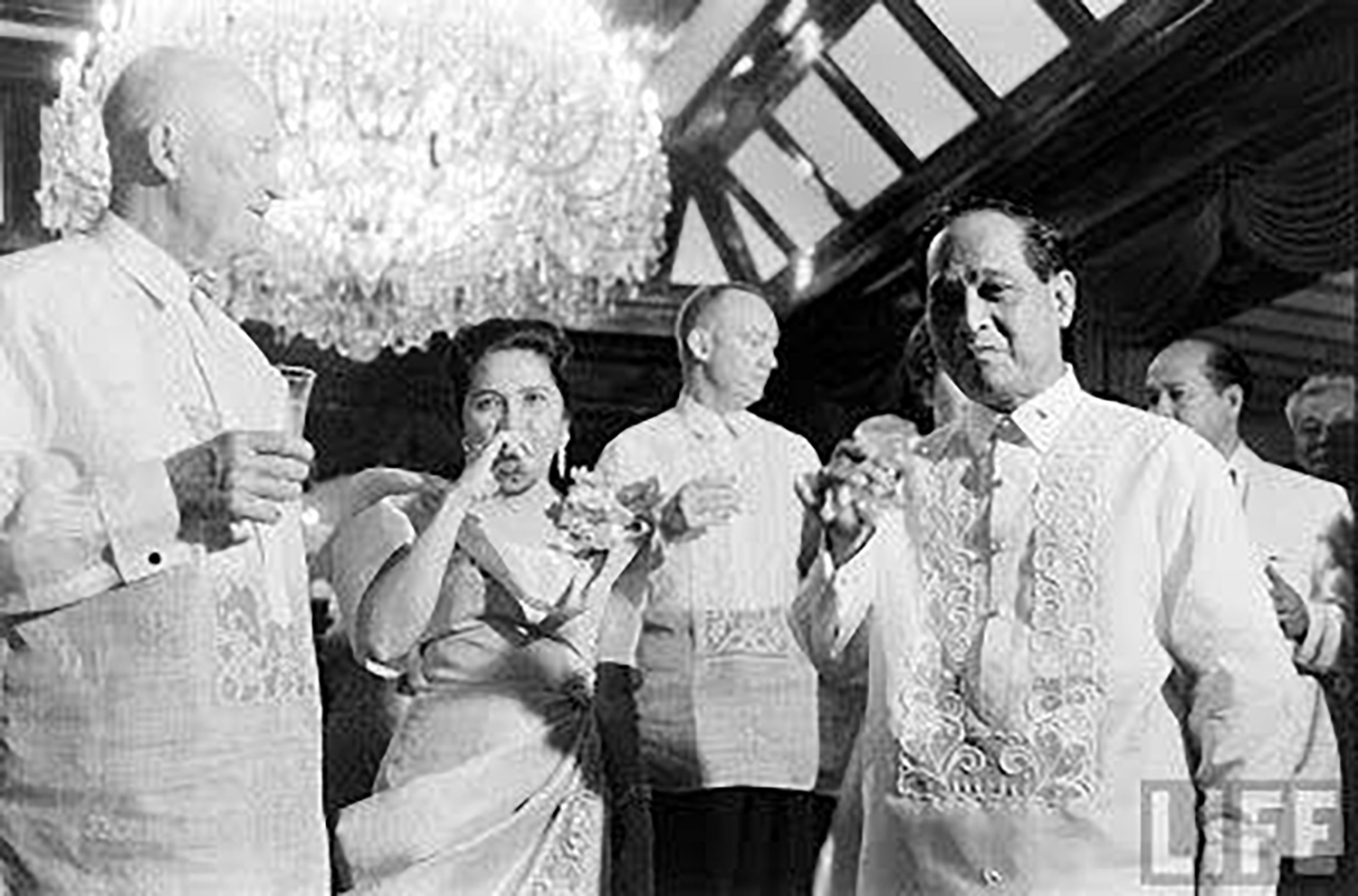
US President Dwight Eisenhower with First Lady Leonila Garcia and President Carlos Garcia in a state dinner at Malacañang Palace in Manila.
That friendship soon led to one of the proudest moments of the designer’s life. He had the opportunity to dress not only the First Lady Leonila D. Garcia but also President Carlos P. Garcia during his term. It was also during this time that the President of the United States, Dwight Eisenhower, came for an official visit to Manila. The designer was able to make clothes for the President, his daughter, and his staff.
“Eisenhower even asked for discounts on the barong Tagalog,” Tito Pitoy laughed.
Tito Pitoy then asked if I could find a terno he had made for my Lola, the former First Lady, which she wore for President Eisenhower’s state visit in 1960.
“How about her other ternos, dated from the 1920s to the 1960s?” I offered.
He lit up.
I scoured my Lola’s extensive closet—it felt like unearthing a legacy. Tucked behind layers of vintage ternos from countless fashion designers, I found that terno, which was photographed by Dick Baldovino along with other pieces for the book project. Once the project was finished and I myself had moved on, my bond with Tito Pitoy never wavered.
When my Lola passed away, he was deeply touched when I personally informed him of the sad news. Once, at the wake of former Vice President Salvador Laurel, he asked me to assist him in the placement of the medals in the chapel.

Philippine Costume by Jose Moreno is the designer’s collection of images and heritage expressed in clothing.
Tito Pitoy later invited me to his 80th birthday celebration—a dazzling Manila affair in 2012. During the evening’s festivities, he handed me a printed copy of Philippine Costume and added warmly,
“Thank you, hijo. I’ll call on you for the next one.”
The highlight of his career—and his most unforgettable moment—came during the Metro Magazine Gala fashion show: A Tribute to Pitoy Moreno, Fashion Icon. A collection of evening gowns spanning six decades—many of them unseen and tucked away in his atelier—were revealed that night. When the finale came, Tito Pitoy walked the stage, triumphant and waving to a sea of admirers. Longtime friends from the industry, society’s finest, and fashionistas rose from their seats and gave him a standing ovation.
It wasn’t just to celebrate his craft and ingenuity—it was to honor the man who brought elegance, history, and heart in every stitch.
Arts & Culture
Queer Coding in Cinema: The Best Shows to Binge for Pride Month 2025

compiled by Edge Javier
As Pride Month 2025 goes into full swing, the best way to celebrate LGBTQIA+ voices is with a binge-worthy lineup of shows that center queer stories, joy, love, resilience — and yes, of course, drama. From groundbreaking recent series to must-watch staples and fan favorites, here are the top shows to stream this June that reflect the vibrant spectrum of the queer-coded experience.
1. Heartstopper – Season 3 (Netflix)
Nick and Charlie are back, and the coming-of-age sweetness is stronger than ever. Season 3 explores deeper emotional territory while keeping the wholesome tone fans adore. Expect more queer joy, nuanced relationships, and tearjerker moments that feel like a warm hug.

2. Drag Me to Dinner (Hulu)
Hosted by Neil Patrick Harris, this chaotic culinary competition pairs drag duos in a battle to throw the most fabulous themed dinner party. With outrageous challenges, surprise twists, and plenty of camp, queens serve up equal parts food, flair, and fierce shade. It’s RuPaul meets Top Chef—served with a side of sequins.

3. Queer Planet (Apple TV+)
Hosted by Janelle Monáe, this visually stunning docuseries dives into queerness in the animal kingdom and parallels in human identities. It’s smart, groundbreaking, and perfect for those who want to feel seen—and informed.

4. Fellow Travelers (Paramount+)
This period romance-drama set during the Lavender Scare continues to grip audiences with its tragic beauty and sharp historical insight. If you missed Season 1, now is the perfect time to catch up before the highly anticipated Season 2 lands later this year.

5. The Buccaneers – Season 2 (Apple TV+)
The unapologetically queer period drama returns with more scandal, sapphic yearning, and feminist rebellion among American heiresses navigating high society in 1870s London. Think Bridgerton, but with more edge and better sapphic representation.

6. Our Flag Means Death – The Finale Special (Max)
This fan-favorite pirate rom-com wraps up with a one-hour finale special airing this June. Whether you’re rewatching from the start or jumping into the last hurrah, this show remains a shining example of queer love told with heart and humor.

7. This Is Me Now… The Series (Prime Video)
Following Jennifer Lopez’s genre-blurring film-musical hybrid, the series version delves into themes of love, identity, and self-acceptance, and features cameos by queer icons and allies. It’s campy, messy, and made for Pride Month mood-boosting.

8. Sort Of – Final Season (Max)
This critically acclaimed dramedy about a gender-fluid millennial navigating love, grief, and identity in Toronto comes to a close with an emotionally rich final season. A thoughtful and often hilarious story that never loses its beating heart.

9. Red, White & Royal Blue – Limited Series (Prime Video)
After the hit film adaptation, the beloved queer romance returns in a serialized format, expanding on Alex and Henry’s story with new twists and deeper character arcs. It’s romantic escapism, elevated.

10. POSE: The Legacy (FX/Hulu)
This documentary miniseries honors the cultural legacy of POSE and the real-life ballroom legends who inspired it. Featuring interviews with cast, creators, and icons from the scene, it’s a must-watch tribute to queer history and resilience.

Whether you’re looking for laughter, tears, romance, or revolution, these Pride Month picks for 2025 offer it all—while honoring the complexity and beauty of LGBTQIA+ lives. So press play, turn up the volume, and let queer stories shine this June and beyond. Happy Pride! 🏳️🌈
Arts & Culture
Chaos and Clarity: Zen Aesthetic in Oj Hofer’s Art

by Jing Ramos |
Oj Hofer, our fashion contributing editor, is a Fine Arts graduate from the University of the Philippines. Though he began painting at the age of eight, his artistic journey took a transformative turn in 2013. While volunteering as a costume designer for Siddhartha: The Musical, he encountered Venerable Master Hsing Yun’s One-Stroke Calligraphy, sparking a deep devotion to Japanese sumi-e painting and kanji calligraphy. Over the years, he refined his craft, using his art to share the Dharma through exhibitions while supporting the Hsing Yun Educational Foundation. In 2022, his spiritual path deepened at Nan Tien University, where he embraced Zen and Humanistic Buddhism, shaping his artistic philosophy.
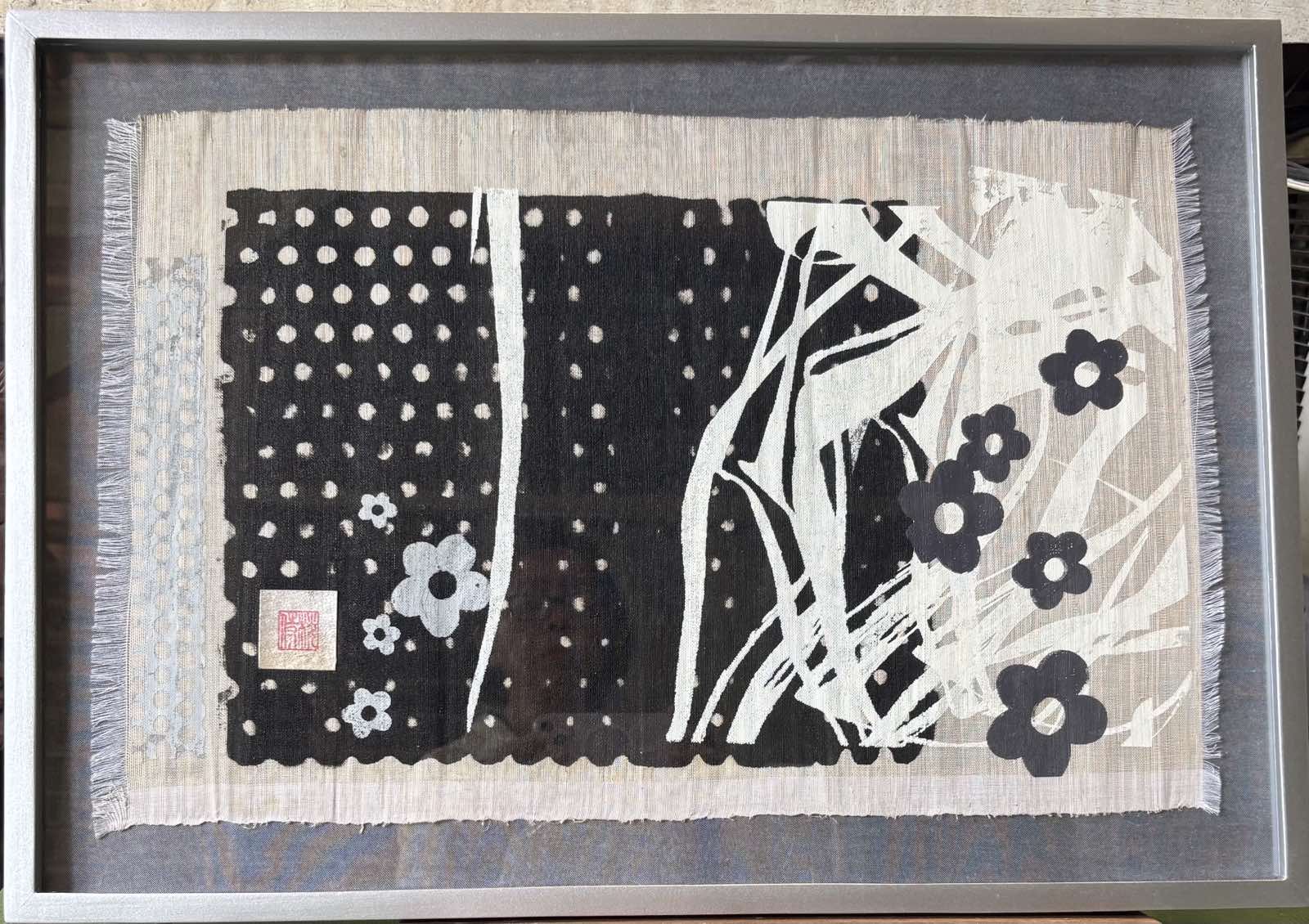
“Plum Blossoms in Moonlight.” Serigraphy on abaca.
In his recent works, Hofer merges traditional calligraphy with serigraphy, drawing inspiration from his friend Charles Lahti—an internationally recognized New York-based painter and printmaker. Lahti, known for his collaborations with post-war American artists like Robert Rauschenberg, Donald Judd, Andy Warhol, and LeRoy Neiman, introduced Hofer to silkscreen techniques. Through a workshop Lahti conducted in Cebu—arranged by their mutual friend Greg Urra—Hofer integrated silkscreen into his Zen artworks, particularly those on abaca.

“The Circle of Harmony” Serigraphy and Calligraphy on abaca.
Hofer’s cross-disciplinary approach challenges conventional Zen aesthetics. His layered paintings on abaca may seem far from tranquil at first glance, but closer contemplation reveals a meditative core. His serigraph of an Enso circle, for example, initially appears chaotic, filled with Tang Dynasty poetry and overlapping, repetitive forms. Yet, by focusing on a single calligraphic element, the viewer experiences a moment of clarity—a glimpse of awakening within the visual complexity.
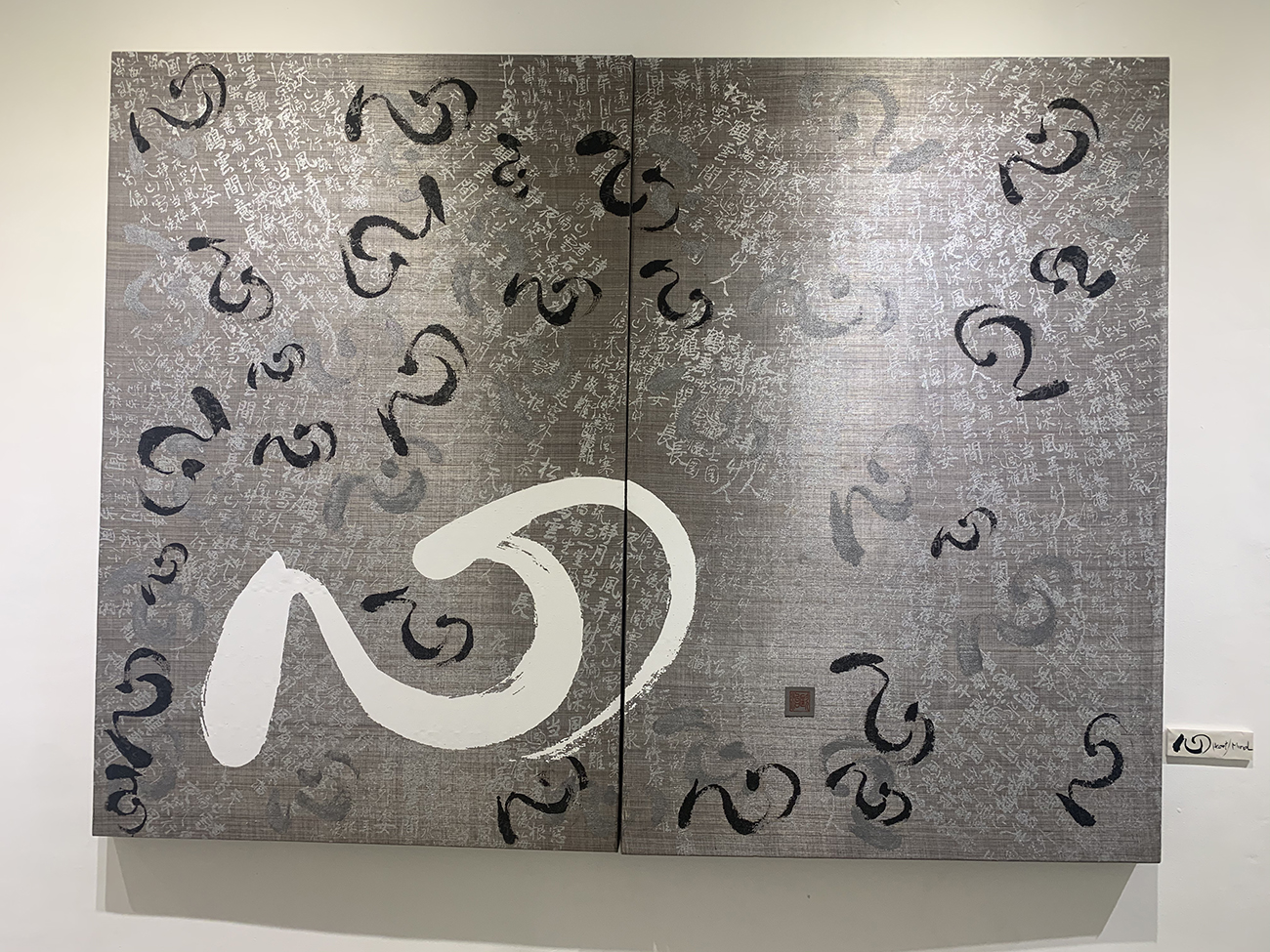
“Monkey Mind” Serigraphy and Calligraphy on abaca.
Even more engaging is his diptych Monkey Mind. At odds with the traditional Zen emphasis on negative space, this piece is deliberately busy, reflecting the restless nature of the mind. A distracted viewer may struggle to find a focal point, but one attuned to emptiness and presence will perceive clarity amidst the seeming disarray.

Ink and intention—creating calligraphy in support of one of my advocacies.
By fusing Zen philosophy with the discipline of serigraphy, Hofer invites his audience to look beyond surface impressions and discover stillness within movement, balance within complexity. His art does not merely depict Zen—it embodies the paradoxes at its core, offering a path to mindfulness through the act of seeing and the experience of doing.
-

 QuickFx3 months ago
QuickFx3 months agoHill Station Baguio-Mitos Benitez-Yñiguez Raises the Bar with a Gastronomic Experience in a Cultural Heritage Building
-

 People2 months ago
People2 months agoA Destination Wedding in Capiz; A Love Story in Focus
-

 Prime Target2 months ago
Prime Target2 months agoMucho Garcia: Cebu to NYC — Living the Dream, One Role at a Time
-

 Arts & Culture1 month ago
Arts & Culture1 month agoAsia’s Fashion Czar I Knew as Tito Pitoy; Remembrance of a Friendship Beyond Fashion with Designer Jose R. Moreno
-

 Pride Month2 months ago
Pride Month2 months agoDrag: How Performance Art Turns the Scene into Protest in Cebu
-

 Design3 months ago
Design3 months agoNew York Celebrates the Art Deco Centennial-Icons of Style and Innovation
-
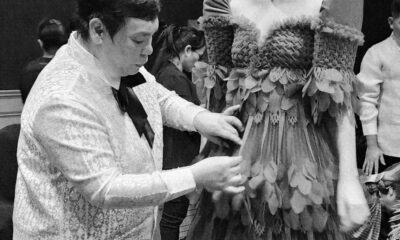
 Fashion2 months ago
Fashion2 months agoBehind the Scenes: Backstage at The Philippine Terno Fashion Show 2025 in the Waterfront Cebu City Hotel & Casino
-
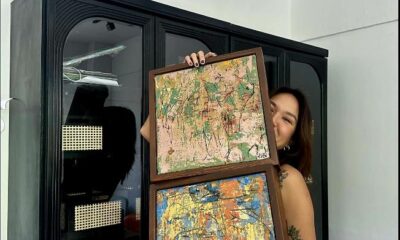
 Prime Target1 month ago
Prime Target1 month agoMia Durano: Shaping Art Into Brand


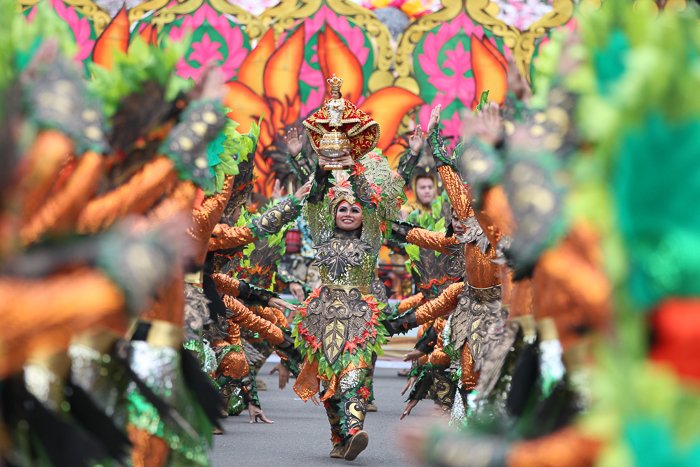



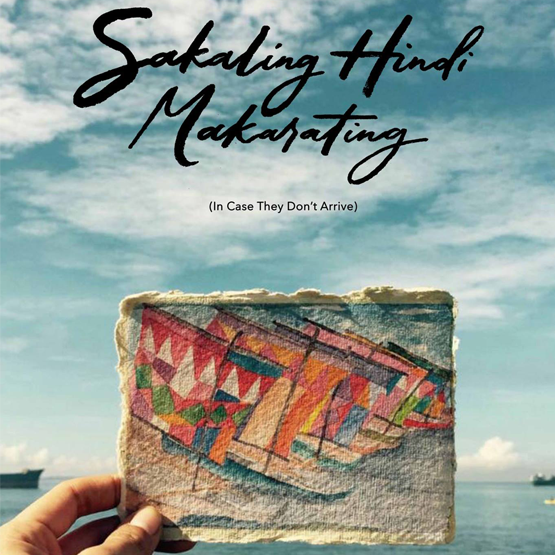





You must be logged in to post a comment Login